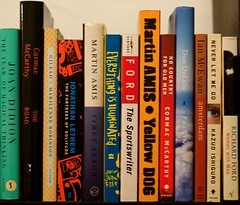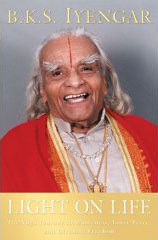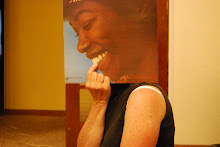I’m upset this morning, having read the headline and story about Philip Garido’s kidnapping, rape and 19-year incarceration of Jaycee Lee Dugard. She was abducted when she was eleven years old. I can’t imagine what that little girl went through.
This story is shocking because of the youth of the child and the way years were stolen from her childhood, her life. It’s more shocking because such stories are very unusual in the U.S. or anywhere in the first world. When we hear about such an outrage we are stunned, but throughout the world such stories would be more commonplace, if the child victims had a voice to tell them.
That story was a reminder about what kids all over the world suffer due to their lack of power. One of my students once told me about how she left her country. Let’s call her Grace. She was six when soldiers came to her village in Sierra Leone, and burned it. Her parents were killed, and Grace and her 10-year-old brother ran. They ran and ran until they had run right across the country, from Sierra Leone into Guinea, the ten-year-old protecting the six-year-old. My own son was ten at the time and I was aghast at the prospect of a child of that age looking after himself, let alone a younger child. The children I have known just didn’t have very much commonsense at that age. I guess that little boy, Grace’s brother, learned fast, and Grace kept it together in unimaginable circumstances, somehow, until she and her child managed to arrive in Australia, after many years in refugee camps.
The stories of children are more compelling than those of adults because their suffering is more tragic. They have no power to change their circumstances and overcome their oppression. We must feel for them. I support Oxfam because of their successful program which frees child soldiers.
The militias which kidnap children and force them to become soldiers are proxies of multinational companies and foreign powers. See http://www.globalwitness.org/media_library_detail.php/782/en/global_witness_uncovers_foreign_companies_links_to_congo_violence
Because we all consume the products which are developed from the raw materials mined in places like the Congo, we are all culpable in this kidnapping and torture of children.
Friday, August 28, 2009
My Music Wen Go
The music on my blog started playing up recently (no pun intended). I had hoped that it would just go on playing there in the background ad infinitum and I would add a new sound file now and then, when I intuited my readers might feel like hearing something new (or when I did). (BTW, if you're interested in quirky bits of information about English, click the link to "ad infinitum" and follow the links on that page.)
But today, I am informed, my playlist is empty. And so, I had to root around again through all my connections and links to work out where I got it from.
The google search "how to put music on my blog" led me to blogger help and a list of sites that store playlists. I know I used one of them, as blogger help was my only mentor when I was setting up. So, clicked through the list of links looking for one whose home page I recognised. Not the first, or second, or third. I wondered why I hadn't just chosen the first or second music host. Would have been the easiest option. But then I remembered that I was looking for David Parsons and gamelan
So eventually clicked "Playlist", which was recognisable, and so I think it's my host. The only problem was that it was down. Have just checked and I see that it's back up again, but now I appear to have another problem. Due to "licensing restrictions" it appears that some of my tracks (all of them, it seems) are no longer playable. Well, this gives me some research to be going on with today. I didn't realise there was a timelimit on hosting music. Must look closely at the terms & conditions at Playlist. Does anyone know anything about playlist hosting?
Have just dropped in at Playlist. It appears that Playlist will no longer host music for non-US members. I was directed, by another Playlist user, to imeem, but imeem only hosts 30 seconds of a track AND they wish to access your email list. Don't like that. Don't think my email contacts will like being emailed. No, I have to find another host. I'm wondering if 30 seconds is the norm for hosting music tracks. If you have any idea about this, please let me know.
(About my blog title: it's Hawai'i Creole English. "Wen" is a past tense marker, to which the infinitive is attached, in this case "go". )
But today, I am informed, my playlist is empty. And so, I had to root around again through all my connections and links to work out where I got it from.
The google search "how to put music on my blog" led me to blogger help and a list of sites that store playlists. I know I used one of them, as blogger help was my only mentor when I was setting up. So, clicked through the list of links looking for one whose home page I recognised. Not the first, or second, or third. I wondered why I hadn't just chosen the first or second music host. Would have been the easiest option. But then I remembered that I was looking for David Parsons and gamelan
 Image via Wikipedia
Image via Wikipedia
So eventually clicked "Playlist", which was recognisable, and so I think it's my host. The only problem was that it was down. Have just checked and I see that it's back up again, but now I appear to have another problem. Due to "licensing restrictions" it appears that some of my tracks (all of them, it seems) are no longer playable. Well, this gives me some research to be going on with today. I didn't realise there was a timelimit on hosting music. Must look closely at the terms & conditions at Playlist. Does anyone know anything about playlist hosting?
Have just dropped in at Playlist. It appears that Playlist will no longer host music for non-US members. I was directed, by another Playlist user, to imeem, but imeem only hosts 30 seconds of a track AND they wish to access your email list. Don't like that. Don't think my email contacts will like being emailed. No, I have to find another host. I'm wondering if 30 seconds is the norm for hosting music tracks. If you have any idea about this, please let me know.
(About my blog title: it's Hawai'i Creole English. "Wen" is a past tense marker, to which the infinitive is attached, in this case "go". )
Wednesday, August 26, 2009
Talking Books II (London Fields)
What do they say? If you do the same thing twice and expect to get a different result, you're fooling yourself? Or are you mad? Can't remember.
I admit that many of the talking books I have listened to have been annoying, frustrating, and sometimes so irritating that I have given up the fight & decided that I just wouldn't waste the time (e.g., "Middlesex"; see my July entry "Talking Books" .) But I have listened to a good one or two along the way ("Lord of the Rings", "People of the Book", "The Poisonwood Bible").
And so I came to Martin Amis' "London Fields" in the local library. Meaty!
"London Fields" is read by Steven Pacey, and I think he generally does a good job. He does a New York accent, a cockney accent, an upper-class twit accent, a Jamaican-London accent, all very creditably, I think. But as with the readers of "Middlesex" and "The Unknown Terrorist", where this reader falls down, is when he tries to portray an important female character. I don't believe Nicola Six. It's not just that the accent is not very good, not like the Balkan English accents I'm familiar with. But also, Nicola's dialogue doesn't sound like it is delivered by a sexy woman, more like a chain-smoking drag queen. And so I can't buy it that all the male characters are in love with her, which is a big disadvantage for this novel, whose plot turns on her ability to manipulate the men and so bring about the climax of the novel.
On the one hand, I blame the actor for my inability to suspend my disbelief and live in the world of the novel for a couple of weeks. On the other hand, I have a nagging doubt about the novelist's skill. So I go to the critics because, as I said in my earlier entry on talking books, after my encounter with the talking book, I could not bear to read the print version now.
Most of the more recent reviewers laud "London Fields" as one of Amis' best and some go so far as to say it's a modern masterpiece. I only found one review that I was able to agree with: "What can Amis have against these minimally developed characters that he devotes nearly 500 pages to demolishing them? There's disgust aplenty here — but little else" (Library Journal). There is more damning criticism from reviews written soon after 1989, when the novel was published. But I still can't decide whether my opinion of the novel would have been different had I read rather than heard it. I know I liked "The Information", published a year or two before "London Fields", very much.
Am I arguing with the novel or the reader?
 Image by Kilgub via Flickr
Image by Kilgub via Flickr
I admit that many of the talking books I have listened to have been annoying, frustrating, and sometimes so irritating that I have given up the fight & decided that I just wouldn't waste the time (e.g., "Middlesex"; see my July entry "Talking Books" .) But I have listened to a good one or two along the way ("Lord of the Rings", "People of the Book", "The Poisonwood Bible").
And so I came to Martin Amis' "London Fields" in the local library. Meaty!
 Cover of LONDON FIELDS
Cover of LONDON FIELDS
"London Fields" is read by Steven Pacey, and I think he generally does a good job. He does a New York accent, a cockney accent, an upper-class twit accent, a Jamaican-London accent, all very creditably, I think. But as with the readers of "Middlesex" and "The Unknown Terrorist", where this reader falls down, is when he tries to portray an important female character. I don't believe Nicola Six. It's not just that the accent is not very good, not like the Balkan English accents I'm familiar with. But also, Nicola's dialogue doesn't sound like it is delivered by a sexy woman, more like a chain-smoking drag queen. And so I can't buy it that all the male characters are in love with her, which is a big disadvantage for this novel, whose plot turns on her ability to manipulate the men and so bring about the climax of the novel.
On the one hand, I blame the actor for my inability to suspend my disbelief and live in the world of the novel for a couple of weeks. On the other hand, I have a nagging doubt about the novelist's skill. So I go to the critics because, as I said in my earlier entry on talking books, after my encounter with the talking book, I could not bear to read the print version now.
Most of the more recent reviewers laud "London Fields" as one of Amis' best and some go so far as to say it's a modern masterpiece. I only found one review that I was able to agree with: "What can Amis have against these minimally developed characters that he devotes nearly 500 pages to demolishing them? There's disgust aplenty here — but little else" (Library Journal). There is more damning criticism from reviews written soon after 1989, when the novel was published. But I still can't decide whether my opinion of the novel would have been different had I read rather than heard it. I know I liked "The Information", published a year or two before "London Fields", very much.
 Image via Wikipedia
Image via Wikipedia
Am I arguing with the novel or the reader?
Friday, August 21, 2009
Wednesday, August 19, 2009
What are you reading?
![riemann surface of Sqrt[z], projection from 4d...](http://upload.wikimedia.org/wikipedia/commons/thumb/e/e4/Riemann_surface_sqrt.jpg/300px-Riemann_surface_sqrt.jpg) Image via Wikipedia
Image via Wikipedia
Sweet story about the friendship between a housekeeper, her son, and the former maths professor who she keeps house for. The professor has been in a car accident, and, as a result, can only retain the previous 80 minutes in memory. After 80 minutes, he remembers only the long-term memories he had at the time of his accident more than thirty years ago. He loves the housekeeper's son and calls him "Root" because the top of his head is flat just like the square root sign.
On "First Tuesday Book Club", Marieke Hardy gave the book a less than complimentary review, saying something to the effect that it attempted to make maths look like fun, but she didn't buy it. I did, although I hated the subject at school, and was greatly relieved when I didn't have to study it as an undergraduate at uni, only to despair again when it reared its head as statistics in more recent courses. "Standard deviation", I can remember, at least the name, if not the definition. And "fishing trip", and "sample size", but not much else. But the novel, and its maths was fascinating.
 Cover of Half of a Yellow Sun
Cover of Half of a Yellow Sun
So many books, so little time. I can't afford to be reading too many books twice.
Sunday, August 9, 2009
Spicks and Specks
I went on a
When I am with a group of friends, family or students and taking photos, I try to avoid getting my big head into t
I was with a group of adults and kids and the kids were rubbing the lucky snout of the bronze boar outside Sydney Eye Hospital. I was setting up the photo. A young woman in jeans and unencumbered by a bag, approached me and offered to take a photo of all of us. I considered for about half a second--as I said, I'm not overly eager to get into photos; I'm also reluctant to let other people handle my camera--and then politely declined. I momentarily looked through the viewfinder to line up the shot of the child and the boar and then my eyes glanced at the spot where I had last seen the young woman. She was not there. She was not anywhere. She had vanished into the ether of Macquarie Street.
Back to the weekend outing. I got off the train at Circular Quay and pegged a couple of exiting passengers as fellow students. Something about their demeanor, their ages and their luggage. I expected them to be on the same trajectory as me. But they weren't at the rendezvous. As I rolled up to the doorway of The Museum of Contemporary Art at 8.15, a middle-aged Asian man, similarly encumbered to me, was approaching too. I smelt him before he got very close. Cigarettes. He wasn't smoking but he smelt like a bank of ashtrays. I'm not used to the cigarette pong these days. I stopped smoking six years ago. Very few of my friends and colleagues smoke now. In the early morning air, with just two of us at the doorway, he reeked. I moved upwind of him.
My classmate (let's call him Renaldo) talked volubly and laughed genially at his own jokes for the next quarter hour while we waited at the wrong spot. At 8.35 we approached a group of likely-looking people standing 100 metres away around a bench. (Most bore the tell-tale signs of photography buffs: SLR cameras, bulky bags, comfortable shoes and well-worn visages.) I saw the two people I had picked as photography class groupies when I got off the train.
Renaldo & I were introduced to the classmates with whom we would spend the next eight hours by our teacher, Garry, who lit up, as he went over the day's programme and route. Two of my classmates lit up, too. That was my first lesson: photography is collocated with smoking. (Or maybe I just don't get out much.)
It dawned on me that Garry thought Renaldo and I were a couple, as he explained that we could share lenses. (Not bloody likely, I thought, as I had already heard too many of Renaldo's pleasantries in the quarter hour we had kept company. I spent the rest of the day putting distance between us. I reasoned that the group--and Garry--could share the wear.)
As the class progressed up through Circular Quay to the Opera House, Garry explained some things about composition, and then about using the A (Aperture) setting on our cameras. This was a revelation to me as I'd only ever used the Auto setting. The others seemed to get it. I had no idea which bits of the camera to look at or which switches to flick. (My fault: I'd overestimated my own ability.) Garry spoke patiently, and looked at my last few shots. Blue! Ah yes. I had the camera set for an incandescent light source. (I had been reading the camera manual feverishly the night before and playing with the settings. I'd forgotten to put them back to normal.)
When Garry looked closely at my camera, he suggested I buy a cleaning kit. He said my lens was a bit dirty. That it made a difference. When I looked at my photos that night, I knew he was right: most of my photos were speckled. I had thought the spicks and specks were too small to affect the photographs. In fact, a camera shop guy told me so years ago. But they did make a difference. The tiny spots on photo after photo superimpose blotches of disappointment over the whole day.
At five o'clock, the now depleted group returned via the Argyll Walk to Circular Quay station.
 I walked up the stairs to platform 1 with a classmate--let's call him Alan. I asked him about his experience with photography and photography classes, and as the train lurched through the tunnels, he told me a little about his life. In quick succession I learned that he was a teacher, that his wife had died six months ago. That she was his second wife, and the first one had died a couple of years before that.
I walked up the stairs to platform 1 with a classmate--let's call him Alan. I asked him about his experience with photography and photography classes, and as the train lurched through the tunnels, he told me a little about his life. In quick succession I learned that he was a teacher, that his wife had died six months ago. That she was his second wife, and the first one had died a couple of years before that.
That evening I looked over the badly-lit, speckled productions from the day's excursion, and edited them removing the tiny blotches and dark blots. I though about the journey back home in the train. Alan with his sadness just below the surface, something that he'll have to live with and ruminate on every day. Something that can't be removed from the big picture.
 Image by frangipani photograph via Flickr
Image by frangipani photograph via Flickr
When I am with a group of friends, family or students and taking photos, I try to avoid getting my big head into t
 Image by tobym via Flickr
Image by tobym via Flickr
I was with a group of adults and kids and the kids were rubbing the lucky snout of the bronze boar outside Sydney Eye Hospital. I was setting up the photo. A young woman in jeans and unencumbered by a bag, approached me and offered to take a photo of all of us. I considered for about half a second--as I said, I'm not overly eager to get into photos; I'm also reluctant to let other people handle my camera--and then politely declined. I momentarily looked through the viewfinder to line up the shot of the child and the boar and then my eyes glanced at the spot where I had last seen the young woman. She was not there. She was not anywhere. She had vanished into the ether of Macquarie Street.
 Image via Wikipedia
Image via Wikipedia
Back to the weekend outing. I got off the train at Circular Quay and pegged a couple of exiting passengers as fellow students. Something about their demeanor, their ages and their luggage. I expected them to be on the same trajectory as me. But they weren't at the rendezvous. As I rolled up to the doorway of The Museum of Contemporary Art at 8.15, a middle-aged Asian man, similarly encumbered to me, was approaching too. I smelt him before he got very close. Cigarettes. He wasn't smoking but he smelt like a bank of ashtrays. I'm not used to the cigarette pong these days. I stopped smoking six years ago. Very few of my friends and colleagues smoke now. In the early morning air, with just two of us at the doorway, he reeked. I moved upwind of him.
My classmate (let's call him Renaldo) talked volubly and laughed genially at his own jokes for the next quarter hour while we waited at the wrong spot. At 8.35 we approached a group of likely-looking people standing 100 metres away around a bench. (Most bore the tell-tale signs of photography buffs: SLR cameras, bulky bags, comfortable shoes and well-worn visages.) I saw the two people I had picked as photography class groupies when I got off the train.
Renaldo & I were introduced to the classmates with whom we would spend the next eight hours by our teacher, Garry, who lit up, as he went over the day's programme and route. Two of my classmates lit up, too. That was my first lesson: photography is collocated with smoking. (Or maybe I just don't get out much.)
It dawned on me that Garry thought Renaldo and I were a couple, as he explained that we could share lenses. (Not bloody likely, I thought, as I had already heard too many of Renaldo's pleasantries in the quarter hour we had kept company. I spent the rest of the day putting distance between us. I reasoned that the group--and Garry--could share the wear.)
As the class progressed up through Circular Quay to the Opera House, Garry explained some things about composition, and then about using the A (Aperture) setting on our cameras. This was a revelation to me as I'd only ever used the Auto setting. The others seemed to get it. I had no idea which bits of the camera to look at or which switches to flick. (My fault: I'd overestimated my own ability.) Garry spoke patiently, and looked at my last few shots. Blue! Ah yes. I had the camera set for an incandescent light source. (I had been reading the camera manual feverishly the night before and playing with the settings. I'd forgotten to put them back to normal.)
When Garry looked closely at my camera, he suggested I buy a cleaning kit. He said my lens was a bit dirty. That it made a difference. When I looked at my photos that night, I knew he was right: most of my photos were speckled. I had thought the spicks and specks were too small to affect the photographs. In fact, a camera shop guy told me so years ago. But they did make a difference. The tiny spots on photo after photo superimpose blotches of disappointment over the whole day.
At five o'clock, the now depleted group returned via the Argyll Walk to Circular Quay station.
That evening I looked over the badly-lit, speckled productions from the day's excursion, and edited them removing the tiny blotches and dark blots. I though about the journey back home in the train. Alan with his sadness just below the surface, something that he'll have to live with and ruminate on every day. Something that can't be removed from the big picture.
Saturday, August 1, 2009
Yoga & the second toe
Have just returned from Iyengar yoga class. Today we worked on getting the second toe to cleave to the big toe (or hallux) and so encourage our inner thighs down towards our inner heels. Not sure whether I've got this right or if I will remember the inner thigh inner heel connection the next lesson. I'm also trying to suck up my pelvic floor while allowing my groins to relax, and encouraging my armpit chest area to come grandly to the front without splaying my floating ribs.
Up on the walls of our yoga space we have black and white images of BKS Iyengar in all sorts of impossible asanas: I'm wondering if one of his devotees is adept at Photoshop.
My big problem is my knees. They hurt so much I've decided that I won't do the bent leg poses such as Virabhadrasana II and Parsvakonasana any more. (If you follow the link to "asana" Parsvakonasana's the 5th image in the chart.) Or, I won't even make an attempt to the get the thigh and the knee to a rightangle.
Knees are not my only problem. There's a reluctance in the place between my shoulder blades to take up a very pleasing (to my teachers) concave formation. I can get up into forearm balance and handstand, but without much style or elegance, and there's this humpy back, which some of my teachers like to point out to my classmates as a graphic warning about what they should avoid at all costs.
One rather sad thing, as I look back on my life and my many years of practising yoga (though not, I admit, as assiduously as my teachers would approve), is that I was better at it in the past than I am now. Just last year, in fact, I learned, through dedicated home practice, to do an effortless downward dog (adho mukha svanasana).
This is very nearly the first pose I ever practised. It's a foundation pose. I remember thinking last year, when I mastered the pose: "Everyone's always told me to stretch down my heels, but what they should have been telling me is to stretch out my spine". My teacher noticed my improvement when I did the dog. Praised my ankles. But then I promptly forgot how to do it. And I can't seem to work it out again. It's gone. Enlightenment for two weeks and then an ocean of nothing.
 Image by aloofdork via Flickr
Image by aloofdork via Flickr
Up on the walls of our yoga space we have black and white images of BKS Iyengar in all sorts of impossible asanas: I'm wondering if one of his devotees is adept at Photoshop.
My big problem is my knees. They hurt so much I've decided that I won't do the bent leg poses such as Virabhadrasana II and Parsvakonasana any more. (If you follow the link to "asana" Parsvakonasana's the 5th image in the chart.) Or, I won't even make an attempt to the get the thigh and the knee to a rightangle.
Knees are not my only problem. There's a reluctance in the place between my shoulder blades to take up a very pleasing (to my teachers) concave formation. I can get up into forearm balance and handstand, but without much style or elegance, and there's this humpy back, which some of my teachers like to point out to my classmates as a graphic warning about what they should avoid at all costs.
One rather sad thing, as I look back on my life and my many years of practising yoga (though not, I admit, as assiduously as my teachers would approve), is that I was better at it in the past than I am now. Just last year, in fact, I learned, through dedicated home practice, to do an effortless downward dog (adho mukha svanasana).
This is very nearly the first pose I ever practised. It's a foundation pose. I remember thinking last year, when I mastered the pose: "Everyone's always told me to stretch down my heels, but what they should have been telling me is to stretch out my spine". My teacher noticed my improvement when I did the dog. Praised my ankles. But then I promptly forgot how to do it. And I can't seem to work it out again. It's gone. Enlightenment for two weeks and then an ocean of nothing.
Labels:
Adho Mukha Svanasana,
Asana,
B. K. S. Iyengar,
Hallux,
Iyengar Yoga,
Yoga
Subscribe to:
Posts (Atom)
![Reblog this post [with Zemanta]](http://img.zemanta.com/reblog_e.png?x-id=2c56e029-4f15-483a-8d2e-8beb9758ff8a)
![Reblog this post [with Zemanta]](http://img.zemanta.com/reblog_e.png?x-id=1164bc1f-d076-4104-b7c5-9066ff0c7592)
![Reblog this post [with Zemanta]](http://img.zemanta.com/reblog_e.png?x-id=a65b374b-a799-4009-9e38-1f142f1f1a0c)





![Reblog this post [with Zemanta]](http://img.zemanta.com/reblog_e.png?x-id=558b0f1d-637c-4573-9701-ebee15ff6c1c)

![Reblog this post [with Zemanta]](http://img.zemanta.com/reblog_e.png?x-id=7837e898-9431-4597-82f7-06c133f8abfd)

![Reblog this post [with Zemanta]](http://img.zemanta.com/reblog_e.png?x-id=f8381d8a-5f3d-4510-b7f5-8348569ccd16)
